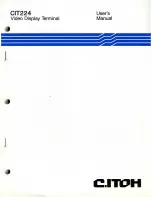
23
The character data is a binary graphical representation of each glyph in a font. Each character is drawn
on a grid containing as many rows as the height specified in the header and as many columns as the
width specified in the character table. Cells are drawn by writing a one in their location and cleared by
setting a value of zero. Starting at the top left, moving right, then down, eight of these cells form a
character data byte. When all cells are accounted for, zeroes may be added to the last byte to complete
it. A sample of an ‘h’ glyph is shown above. The data for the ‘i’ and ‘j’ characters will follow to complete
the custom font file displayed below.
Table 23: Example Font File
Header
5 7 72 74
Character Table
h
0 13 5
i
0 18 3
j
0 21 4
Character Data
h 132 45 152 198 32
i
67 36 184
j
16 49 25 96
6.4
Bitmaps
4.1
Upload a
Bitmap File
Dec
Hex
ASCII
254 94
FE 5E
■
^
ID Size Data
ID Size Data
ID Size Data
Upload a bitmap to a graphic display. To create a bitmap see the Bitmap File Creation section, for upload protocol
see the File Upload Protocol or XModem Upload Protocol entries. Start screen is ID 1.
ID
2 bytes
*
, unique bitmap identification number, LSB first
Size
4 bytes
*
, size of the entire bitmap file, LSB first
Data
variable length, bitmap file data, see Bitmap File Creation example
4.2
Draw a Bitmap
from Memory
Dec
Hex
ASCII
254 98
FE 62
■
b
ID X Position Y Position
ID X Position Y Position
ID X Position Y Position
Draw a previously uploaded bitmap from memory. Top left corner must be specified for drawing.
ID
2 bytes
*
, unique bitmap identification number
X Position
1 byte, leftmost coordinate of bitmap
Y Position
1 byte, topmost coordinate of bitmap
*Note:
To accommodate additional memory, Font and Bitmap IDs have been increased to 2 bytes and size to 4
from firmware revision 8.1 onward. Please query your display revision to ensure this command is issued correctly.
















































